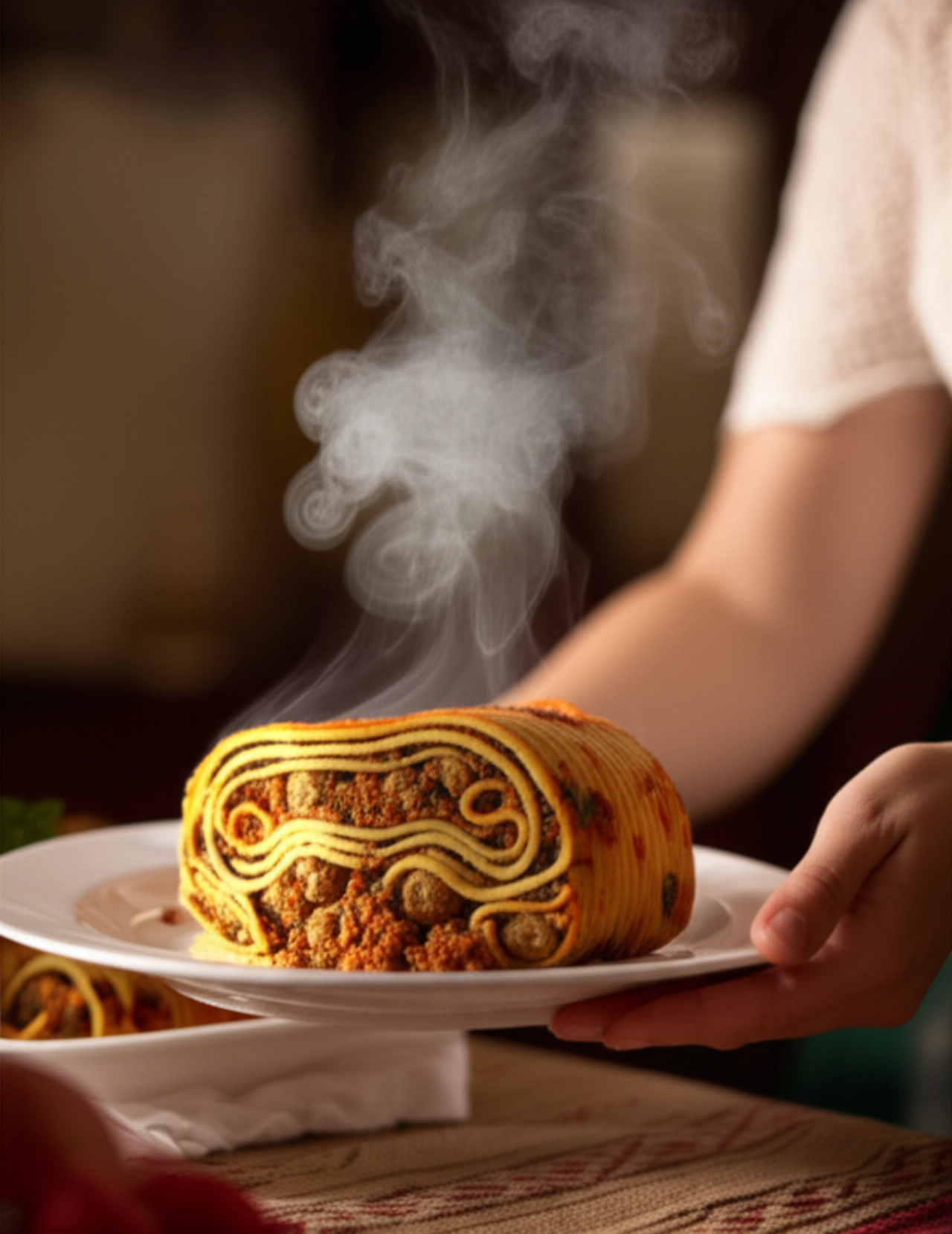Do you dream of bringing to the table an Abruzzese Timballo so sumptuous and flavorful that it makes your guests' eyes light up, a true masterpiece of taste that speaks of tradition and celebration? Imagine layers of thin, velvety crêpes embracing a rich and succulent filling, a triumph of flavors that transports you directly to the heart of the most authentic Abruzzo.
But I know, preparing a Timballo can seem like a titanic undertaking. The fear that the crêpes might break, that the ragù isn't flavorful enough, or that the timballo won't hold its shape when cut, can deter even the most enthusiastic cook. Finding 'that true' recipe, the one passed down from generation to generation, seems almost impossible, and the risk of wasting precious time and ingredients is always around the corner.
Make yourself comfortable, because your search ends here. On this page, you won't just find a list of ingredients, but the definitive, step-by-step guide, full of tricks and tips that only an Abruzzese grandmother or an expert chef could reveal to you. I will guide you through every step to prepare the best, most authentic, and foolproof Abruzzese Crêpe Timballo of your life. Success is guaranteed, and compliments will be your greatest reward!

Smart Ingredients for an Applause-Worthy Timballo: The Choice That Makes a Difference
It's not just a list, it's a promise of success. Every ingredient is fundamental for the final result.
- For the Crêpes (or Scrippelle):
- All-purpose flour (00 flour): Choose good quality, it's the base of our canvas.
- Very fresh eggs: They are the binder that will give elasticity and flavor to your crêpes.
- Whole milk: For a velvety consistency and a golden color.
- A pinch of salt: Don't underestimate it, it enhances the neutral flavor of the crêpes.
- For the Abruzzese Ragù:
- Mixed ground meat (beef and pork): The secret to a rich and deep ragù. Pork adds tenderness and flavor, beef provides structure.
- Pork sausage: Crumbled, it adds a rustic and flavorful touch, typical of Abruzzese tradition.
- Small meatballs: Very small, fried and then immersed in the sauce, they are a must. Use finely ground meat, eggs, Parmesan, parsley, and a pinch of nutmeg.
- Quality tomato passata: The base of our sauce. Choose a thick and sweet passata.
- Tomato paste: To intensify the color and flavor of the ragù.
- Aromatics (carrot, celery, onion): The finely chopped mirepoix for the soffritto, the aromatic base of any good ragù.
- Red wine: For deglazing, it adds complexity and degreases the meat.
- For the Filling and Finishing:
- Provola or scamorza (sweet): Melty cheese that binds everything together and adds creaminess.
- Grated Parmigiano Reggiano: For savoriness and to create that golden crust on the surface.
- Hard-boiled eggs: Cut into wedges, a classic Abruzzese touch that adds color and texture.
- Béchamel sauce (optional but recommended): If you want an even creamier and more enveloping timballo, a light béchamel can make all the difference.

The 3 Mistakes That Can Ruin Your Timballo (and How to Avoid Them)
Don't worry, we're here to learn from common mistakes and overcome them together!
- Crêpes that break or are too thick: The secret is a well-rested batter and a hot non-stick pan, lightly greased only for the first crêpe. Pour the right amount of batter and rotate the pan to distribute it evenly. If they are too thick, add a splash of milk to the batter.
- Insipid or too liquid ragù: A good ragù takes time. Don't rush. Sauté the aromatics well, brown the meat over high heat before deglazing with wine. Then, let it simmer over very low heat, with the lid slightly ajar, to evaporate excess water and concentrate the flavors.
- Timballo that doesn't hold its shape when cut: This happens if the filling is too liquid or if there isn't enough "binder" (like melty cheese or a well-made béchamel). Make sure the ragù is thick and that there's a good amount of cheese between the layers. Furthermore, it's essential to let the timballo rest for at least 15-20 minutes out of the oven before cutting it, so that the flavors settle and everything compacts.

The Extra Touch: The Secret My Grandmother Passed Down to Me
My grandmother, a true Timballo master, always told me: "The secret is not just in the ingredients, but in the love you put into it and in that small detail that makes all the difference." For the Abruzzese Timballo, she never failed to prepare mini meatballs fried separately and add them to the ragù only at the end, before assembling. This not only enriches the flavor and texture but makes every slice a true surprise. And another trick: a pinch of nutmeg in the meatball mixture and in the béchamel (if you use it) incredibly enhances all the flavors. Try it, and you'll taste the difference!
Let's Prepare the Abruzzese Timballo Together: The Step-by-Step Guide
Prepare to create a masterpiece!
Phase 1: The Crêpes (or Scrippelle)
- In a large bowl, whisk the eggs with the salt.
- Add the sifted flour little by little, mixing with a whisk to avoid lumps.
- Incorporate the milk in a stream, continuing to mix until you get a smooth batter without lumps.
- Let the batter rest in the refrigerator for at least 30 minutes (or even an hour). This step is crucial for elasticity.
- Heat a non-stick crêpe pan (or a thick-bottomed pan) and lightly grease it with a small piece of butter or a paper towel dipped in oil only for the first crêpe.
- Pour a ladleful of batter, rotating the pan to distribute it evenly and create a thin layer.
- Cook for about 1 minute per side, until the edges lift and the crêpe is lightly golden.
- Stack the crêpes on a plate, separating them perhaps with parchment paper if you prepare them well in advance. You should get about 15-20, depending on the size.
Phase 2: The Abruzzese Ragù and Meatballs
- Prepare the meatballs: In a bowl, combine the ground meat for the meatballs with an egg, Parmesan, chopped parsley, a pinch of salt, pepper, and nutmeg. Mix well and form very small meatballs (like hazelnuts).
- In a separate pan, fry them in a little oil until golden. Set them aside on absorbent paper.
- In a large pot (preferably earthenware or thick-bottomed), prepare the soffritto with finely chopped carrot, celery, and onion and a drizzle of oil. Sauté gently.
- Add the mixed ground meat and crumbled sausage. Brown over high heat, breaking up the meat well with a wooden spoon, until it is well browned.
- Deglaze with red wine, letting the alcohol evaporate completely.
- Add the tomato passata and tomato paste, a glass of water (or broth), salt, and pepper.
- Bring to a boil, then lower the heat to minimum, cover with a lid slightly ajar, and let simmer for at least 2-3 hours, stirring occasionally. The ragù should be thick and flavorful.
- In the last 15 minutes of the ragù's cooking, add the fried meatballs.
Phase 3: Assembling and Baking the Timballo
- Prepare the béchamel (if using): Melt 50g of butter, add 50g of flour and cook for 1 minute. Pour in 500ml of hot milk in a stream, stirring with a whisk until it thickens. Season with salt and add nutmeg.
- Cut the provola or scamorza into cubes. Grate the Parmesan. Boil the eggs until hard and cut them into wedges.
- Preheat the oven to 180°C (static) or 170°C (fan-assisted).
- Grease a baking dish (round or rectangular, depending on the desired shape) with butter and dust with breadcrumbs or Parmesan.
- Start assembling:
- Spread a thin layer of ragù on the bottom of the dish.
- Arrange a layer of crêpes, overlapping them slightly to cover the bottom well.
- Fill with a generous layer of ragù, some provola cubes, a sprinkle of Parmesan, and some hard-boiled egg wedges. If using béchamel, add a spoonful.
- Repeat the layers until all ingredients are used, finishing with a layer of crêpes.
- Cover the last layer of crêpes with plenty of ragù, a generous sprinkle of Parmigiano Reggiano, and, if desired, a few small knobs of butter for a perfect crust.
- Bake for about 30-40 minutes, or until the surface is well golden and the timballo is bubbling at the sides.
- Once out of the oven, let the Timballo rest for at least 15-20 minutes before cutting it. This is essential for a perfect slice and for the flavors to settle.
Tips and Frequently Asked Questions about Abruzzese Timballo
I know you might still have some doubts, and that's perfectly fine! Here are the answers to the most common questions:
- Can I prepare the crêpes in advance? Absolutely yes! The crêpes can be prepared even the day before and stored in the refrigerator, covered with plastic wrap, or frozen (separated by parchment paper) for future use.
- What about the ragù? Can I make it the day before? In fact, I highly recommend it! The ragù, like all important sauces, gains in flavor if prepared the day before. Let it cool completely and store it in the refrigerator.
- How can I make the Timballo lighter? You can reduce the amount of melty cheeses or omit the fried meatballs, replacing them with ground meat added directly to the ragù. You can also use partially skimmed milk for the crêpes and béchamel.
- Why does my Timballo fall apart when I cut it? Most likely, it hasn't rested enough after cooking. Resting allows the liquids to be reabsorbed and the cheeses to solidify slightly, compacting everything. Also, make sure the ragù is not too liquid.
- Can I freeze the Abruzzese Timballo? Yes, you can freeze the entire timballo or in slices. Let it cool completely, then wrap it well in plastic wrap and then in aluminum foil. It keeps for about 2-3 months. To thaw it, leave it in the refrigerator overnight and then reheat it in the oven covered with aluminum foil, removing it in the last few minutes to let it brown.
Your Masterpiece is Ready: An Embrace of Flavor!
There you have it! Now you no longer just have a recipe, but all the secrets to bring to the table an Abruzzese Timballo that tastes of home, tradition, and love. Every layer tells a story, every bite is a journey into the heart of Abruzzo. You have overcome every fear, you have created something wonderful with your own hands.
Don't be afraid to experiment and make this recipe your own. Cooking is an act of creativity and generosity. But start from this solid and foolproof base, and you'll see that applause will not be lacking, and the taste of home will be your greatest reward.
Have you tried our Abruzzese Timballo recipe? We are very curious to see your masterpiece! Leave a comment below, tell us how it went, or share a photo on Instagram by tagging @CercaRicette.it. If you loved this holiday dish, you can't miss our recipe for the Original Bolognese Ragù for other rich first courses, or for a perfect side dish like Crispy Roasted Potatoes. Enjoy your meal, from your trusted chef grandma!





